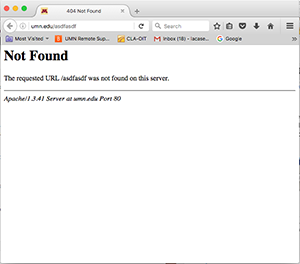University of Minnesota units are responsible for creating standards-compliant websites and applications.
To comply with web standards, websites and applications must have valid HTML, CSS, and JavaScript. They must also meet accessibility standards. Full compliance also includes valid RSS, metadata, XML, SVG, device APIs, and object and script embedding as well as proper settings for character encoding. Web pages should also be optimized for size and download speed.
Accessibility
Web standards are set by the World Wide Web Consortium (W3C). For a complete list, visit the W3C Web Design and Applications Standards website. Since January 1, 2014, the Web Content Accessibility Guidelines (WCAG) 2.1, level AA, serve as the Web accessibility standards for the University of Minnesota.
Accessibility means making your project usable by people of all abilities. Usability means making it easy for your audience to accomplish their goals. Accessible best practices improve the experience for everyone. Visit the Accessible U website for more information about digital accessibility and explore Usability Services that will help inform how your website is used.
Browser and Device Testing
Testing your website on various platforms, browsers, and devices has never been so complicated. Browser testing has grown from testing a handful of browsers on a PC and Mac desktop or laptop to include testing both the display and touch interaction on tablets and phones, all with their own operating systems and browsers.
To make the most of your testing time, consider approaching the task based on your incoming traffic. With students as the main audience for many University sites, the use of mobile devices for web browsing is growing in popularity. Use your analytics to determine the platforms, browsers, and devices your audience is using to look at your sites. Make a list. Test the top 6 or 8 of these first.
Don’t have access to all those device combinations for testing? Emulators or online testing services are the next best thing. Smashing Magazine suggests BrowserStack or Open Device Lab.
Redirects and 404 Pages
When redesigning a website, setting up redirects from your old site’s URLs to the new site’s URLs should be part of your launch plan. Redirects, correctly done, will help your site’s SEO and, when done in conjunction with a custom 404 page, will prevent anyone linking to your old URLs from getting an unhelpful generic 404 page.

Not sure how to make a redirect or create a 404 page? Talk to your IT staff. Or if you are the IT staff, contact central IT for help.
Search Engine Optimization (SEO)
There are many factors to consider when building and writing content for a website to have good SEO. Some basics include:
- Include the word(s) people will search for in your page titles, URLs, and meta descriptions
- Use a balanced number of keywords in your content (2 to 4 percent of your content should be keywords; more than that appears to be keyword stuffing)
- Make your site responsive
- Build a Google site map
- Make sure your site is fast—use Google’s Page Speed Insights